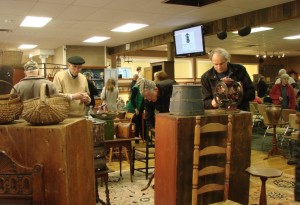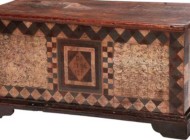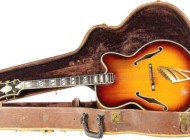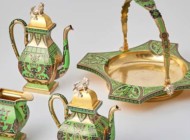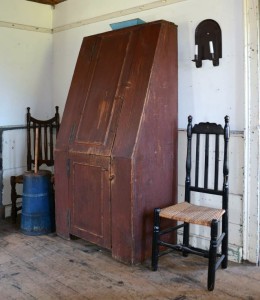
From the strong selection of furniture in original paint, this brown canted-back cupboard was the highest priced item of the sale, earning $12,650. The determined buyer also bought a number of other early items.
Review and Onsite Photos by Rick Russack, Additional Photos Courtesy William A. Smith, Inc.
PLAINFIELD, N.H. — Bill Smith had two good collections of furniture, along with early brass and ceramics, for his Columbus Day sale on October 10. One collection from Gilmanton, N.H., included several pieces of early furniture, and the other, from Newbury, Vt., featured several pieces with old painted surfaces, including a canted-back cupboard that brought the highest price of the day, $12,650. Also doing well were early brass candlesticks, Westerwald jugs, an early bun-foot chest of drawers, trade tomahawks and several banister back chairs.
Possibly the most unusual item of the day was a large, cylindrical storage container of some type. It was about 6 feet tall, perhaps 2 feet in diameter, made of hundreds of interwoven similarly sized tree branches. Some thought it was a “hamper,” some called it a basket, and Smith said he would leave it to the buyer to decide what to call it. Whatever it was, it realized $432. A good-sized crowd was in the salesroom, multiple phone lines were in use, and there were numerous absentee bids. Smith does not use the internet and does not publish a list of prices realized, preferring to allow buyers to keep that information confidential. The lights went out just as he was getting ready to start, and Smith said, “Relax, folks, we can sell in the dark,” but he did not have to.
The collection of early furniture from the Gilmanton home was a continuation of material from Smith’s Labor Day sale. A lift top two-drawer blanket chest with bun feet and in old red/brown sold for $3,738. Its backboard was a huge, single piece of pine. A Pilgrim Century chest of drawers with brass teardrop pulls and black moldings finished at $2,013, going to a buyer in the room. A tavern table with a drawer, unusual turned stretchers and well-turned legs seemed reasonable, bringing $1,115 from a dealer in the room. The same dealer bought several pairs of early brass candlesticks, including a group of three early Dutch sticks, for which he paid $1,265.
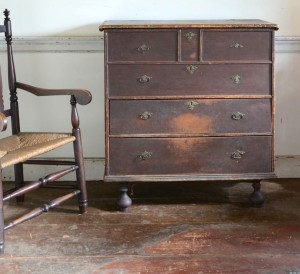
In an old red/brown finish, this two-drawer, lift top blanket chest on bun feet finished at $3,738. The backboard was a single, large piece.
The interesting two-door, canted-back cupboard with an old red-brown surface went to a determined bidder in the room, who obviously liked early things, judging by other items she bought. She competed with multiple phone bidders and paid $12,650 for the cupboard. A small stepback cupboard in a light green paint earned $690, while a good pencil post tester bed in old red achieved $1,150. A grain-painted blanket chest, which Smith thought had been made in Vermont, circa 1820, earned $633. A set of six birdcage Windsors in black paint sold for $2,300, and a black sack back Windsor with a saddle seat ended up at $690.
A David Wood tall case clock with fretwork and three brass finials attained $3,220. Wood worked in Newburyport, Mass., from about 1792 to 1824. He is a well-respected maker, with clocks in the collections of the Metropolitan Museum of Art, as well as in the diplomatic reception rooms in the Department of State. Another early tall case clock, this one by Concord, N.H., maker Levi Hutchins, sold for $2,760. Hutchins served as a fifer in the Revolutionary War, and he and his brother Abel were apprenticed to Simon Willard. The brothers opened their clockmaking shop in Concord in 1786 and continued making clocks together for about 20 years.
Items in the sale ranged from the very primitive — a very heavy flax breaker that brought $190 — to some good early ceramics. When Smith was asked from what kind of wood the flax breaker was made, he answered, “tree wood.” A wanli charger that the buyer said was Chinese and dated from the late Sixteenth Century fetched $1,130. Three English delft chargers, sold in one lot, reached $1,380, and a group of three early Westerwald jugs, one with a pewter top, realized $1,495. An attractive, unusual pair of tin lanterns, painted red and green, sold on a single bid of $230, while a small, painted wooden sign, “Heart’s Content,” earned $334. A 3-gallon jug made by J&E Norton, Bennington, Vt., was decorated with a fenced house and a tree. In spite of condition issues, it realized $978.
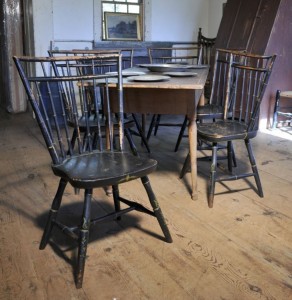
From the Newbury, Vt., collection, this set of six birdcage Windsors in old black paint brought $2,300.
Smith again attracted some younger buyers. Kate Yarborough, a producer of award-winning documentary films from Ferrisburgh, Vt., was there with her toddler, Emrys, and her mother, Sherrill Robinson. She is furnishing a 200-year-old stone house, not far from Lake Champlain. She grew up in a home with antiques and shares the interest with her husband, Finn, who also works with their production company, Earth House Productions. She made several purchases, and said, “It’s a treat to come here.” Smith’s staff is tolerant of children, allowing Emrys to play with his grandmother while his mother was bidding. Smith later commented, “I think younger homeowners in rural areas are more likely to be furnishing with antiques than the more urban or suburban residents. There aren’t any Ikea stores out here.”
Smith has resumed conducting sales in Sarasota, Fla. He works with Crissy Galleries, an active Sarasota antiques dealer. When talking about the merchandise in his Columbus day sale, he talked about competing with other regional auctioneers and believes that his staff is instrumental in securing good consignments. “Everyone here understands the importance of establishing good relationships with our buyers and sellers. The business has changed since my dad started it, but it’s still a ‘people’ business.’”
All prices include the buyer’s premium. For more information, www.wsmithauction.com or 603-675-2549.
[slideshow_deploy id=’1000276815′]
